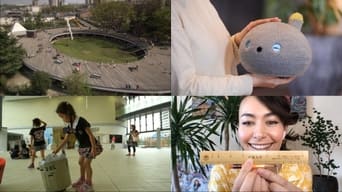DESIGN TALKS plus Season 7

What is good design? And what is its power? From traditional to cutting edge, we explore Japanese designs that are literally shaping our lives.
Watch NowWith 30 Day Free Trial!
DESIGN TALKS plus
2015
What is good design? And what is its power? From traditional to cutting edge, we explore Japanese designs that are literally shaping our lives.
Watch Trailer
With 30 Day Free Trial!
DESIGN TALKS plus Season 7 Full Episode Guide
The kimono is famous around the world as Japan's most famous item of traditional clothing. It offers far more than fashionable beauty; its history has deep roots in Japanese aesthetics and playfulness. New approaches to this item have thrown a spotlight on 21st-century values. Artist Takahashi Hiroko explores the potential of kimono design through the lenses of gender, diversity and sustainability.
On Design Hunts, Andy and Shaula search for designs rooted in regional history and climates. This time they visit Iwate Prefecture whose harsh yet rich natural environment has shaped a unique worldview and given rise to refined designs in ironware and Urushi lacquerware. The region was deeply scarred by the Great East Japan Earthquake of 2011. Explore how Iwate's designs cultivate centuries-old techniques while looking toward the future.
On Design Hunts, Andy and Shaula search for designs rooted in regional history and climates. This time they visit Miyagi Prefecture where residents who survived the Great East Japan Earthquake of 2011 are shaping their memories and recovery through their own efforts. Ishinomaki Laboratory was designed to support residents and their creative endeavors. The remains of Nakahama Elementary School have been transformed into a monument to the damage caused by the tsunami. Explore Miyagi today as it shapes a new future through design.
Today's theme: Design Hunting in Saitama. Rich soil and plentiful rivers mean Saitama has many jobs focused on trees and bonsai. Explore beautifully balanced aesthetics and designs next-door to Tokyo!
teamLab are global leaders of digital art, in the spotlight for a series of new works that were announced during the pandemic. Yet the group are all dedicated to the key concept of physicality. As the world becomes increasingly digital their focus on physical limits has become even sharper. teamLab leader Inoko Toshiyuki explores the necessity and potential of physicality in art and design.
Enchanting and expressive faces, rounded yet flexible bodies. Freedom-loving cats have captivated humanity for millennia, and inspired creators for just as long. They're the most common animal in Japan's ukiyo-e art, and a perfect design motif. Design engineers Ogata Hisato and Sakurai Minoru explore new designs from an animal perspective, focusing on our longtime feline companions.
As the pandemic leads us to avoid physical interaction as a health risk, social divides are widening everywhere. So how can architecture, art and design connect people from different backgrounds and positions? Architect Konno Chie removes the physical and mental barriers that separate people and spaces, creating designs that bring a new vitality to everyday life.
The constant and conflicting information surrounding the pandemic has led to stress and anxiety for many. More than ever, people are seeking wellness and calm. Product designer Sumikawa Shinichi explores physical and spiritual positive designs which promote well-being.
Everything around us has been designed to be convenient. But some are now approaching design with the opposite approach. Professor Kawakami Hiroshi is promoting what he calls the "benefits of inconvenience," and questioning our overly convenient lifestyles. So what does "inconvenient" design really mean? Explore this contrary approach and the new potential for design it reveals.
Upcycling is when new designs and ideas are applied to unwanted or damaged items that would otherwise be thrown out. They're upgraded into entirely new products and given new value. With sustainability a key issue for our planet today, upcycling has become an important new approach. Architect Jo Nagasaka explores a world of new designs, all inspired by upcycling!
The coronavirus pandemic has led to massive upheaval in the hotel industry. The era of city hotels designed around the needs of global business workers has faded. New hotels focused on concepts and systems that suit the demands of today have come to the fore. Creative director Iwasa Toru explores the shift in hotel design from "places to sleep" to "places to learn and think." Join us to discover inspiration for lifestyle changes.
As interest in organized living increases, there's also been a rise in designs that focus on creating neat, clean spaces that help us live in comfort. Hiroshi Yoneya, Ken Kimizuka and Yumi Masuko of design studio TONERICO explore everything from the clean simplicity of tea rooms to cityscapes. Join us on an exploration of the philosophy of Japanese organization through spatial design.
As lockdown keeps more of us at home, people have become drawn to minimalist living, enriching their homes and lives by paring down their belongings to the essentials. From Nagaya homes to tiny Tsubo-niwa and tokonoma alcoves, Japan has a long history of creating space in difficult circumstances. Its traditions maximize the potential of small homes. Architect Koichi Suzuno explores designs that make a minimalist lifestyle a pleasure.
Design is playing an increasingly important role in the way we pass on the culture, climate and memories of each region and city. It's an endeavor far larger than maintaining heritage sites. How do we ensure ordinary buildings survive? That memorials to past disasters do not vanish? And that the vitality and output of an artisans' quarter continues to breathe centuries into the future? Architect Masashi Sogabe explores designs that can capture the memories of cities.
Today's theme is Designing Experiences. Japan's top creative director Kashiwa Sato guides our presenters around his exhibition at The National Art Center. From the design of corporate logos we see every day to kindergartens, hospitals and regional industries - Sato has won acclaim for his work on brand strategy in a truly diverse array of fields. Explore the exhibition and the links between communication and creativity.
Today's theme is Visualize. Japan's top creative director Kashiwa Sato guides our presenters around his exhibition at The National Art Center. From the design of corporate logos we see every day to kindergartens, hospitals and regional industries - Sato has won acclaim for his work on brand strategy in a truly diverse array of fields. Explore the exhibition and the role design can play in the future.
Our topic this time is Part of the Whole. Our guests are up-and-coming architectural duo Masuda Shingo and Otsubo Katsuhisa. By focusing on which elements really need to change, they examine windows, walls and foundations. Their work creates new relationships between architecture and the surrounding environment. As we stand at a turning point for new lifestyles, explore potential futures.
The Mingei movement began in 1926 but still has an enormous impact on Japanese product design today. As we all re-evaluate our lifestyles in the midst of a pandemic, explore how Mingei helped shape the design of ordinary items around Japan. Guest Takaki Takao runs a craftwork shop in Fukuoka and explores what lies ahead for our everyday lives.
Exhaustion and stress are taking their toll as the coronavirus pandemic continues. Supportive, relaxing designs are beginning to attract notice. Meet a pet-style robot designed to have no practical purpose, discover humorous gifts, and charming signs. Product designer Nezu Kota explores the world of compassionate design.
The rise in remote work and workations have led to massive changes in the relationship between our jobs and lives at home. Some have been inspired to reexamine their lifestyles and move from the city to the countryside. Designer Kobayashi Shinya connects craftsmanship and everyday life by reinvigorating local industry. Art director Hirose Kiyoharu works on social design projects that conserve local natural environments. They explore future possibilities for connecting work and home life.
The d47 MUSEUM in Shibuya, Tokyo showcases Japan's 47 prefectures, exploring their unique beauty and culture through regional designs. Guest Nagaoka Kenmei curated its Reverent Design exhibition. Today, he shows us around, explaining how the concept could shape our lives and craftsmanship going forward.
As the world grapples with a global pandemic and environmental crises, many are reexamining their relationships with the objects around them. Guest Nagaoka Kenmei's belief in long-life design offers a way forward. He reevaluates the items that have been made for decades, and become an inextricable part of our everyday lives. Explore the beloved designs which have transcended generations.
Translation: the act of communicating words of one language to those who do not know it. On this episode, Dominique Chen guides Andy and Shaula through an exhibition exploring this very theme through a variety of designs that offer new perspectives on the world from different linguistic and non-linguistic layers. Explore new avenues of communication in an increasingly fragmented world through "Translations."
Free Trial Channels
Seasons










































